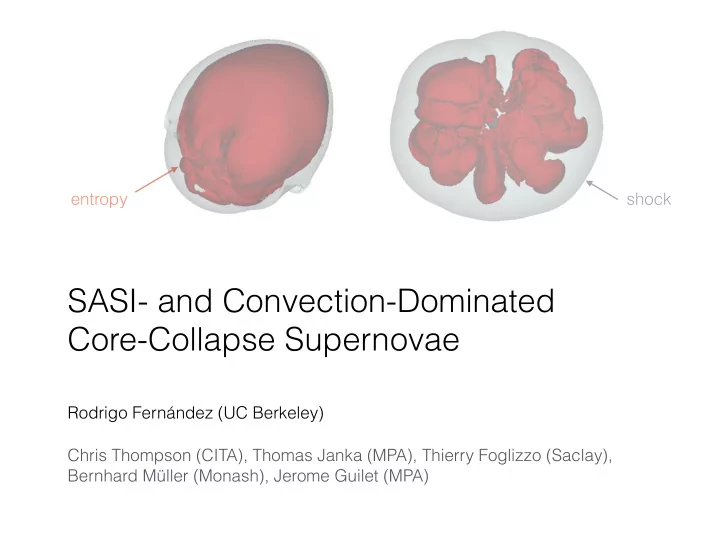

entropy shock SASI- and Convection-Dominated Core-Collapse Supernovae Rodrigo Fernández (UC Berkeley) Chris Thompson (CITA), Thomas Janka (MPA), Thierry Foglizzo (Saclay), Bernhard Müller (Monash), Jerome Guilet (MPA)
Neutrino Mechanism Bethe & Wilson (1985) ν • Works in 1D only for lightest progenitors ν (e-capture SNe) e.g., Kitaura et al. (2006) ν PNS • If iron core formed, need to cooling break spherical symmetry to improve efficiency heating ν Liebendoerfer et al. 2001, Rampp et al. 2002, Thompson et al. (2002), Sumiyoshi et al. (2006)
Hydrodynamic Instabilities (region between PNS and shock) 1. Neutrino-Driven Convection R s ( t ) local, non-oscillatory, heat/buoyancy e.g., Bethe (1990), Murphy et al. (2013) R in 2. Standing Accretion Shock Instability (SASI) global, oscillatory, wave cycle Blondin et al. (2003), Foglizzo et al. (2007)
Buoyancy vs. Advection Normalized Entropy: | ω BV | � χ = | v r | d r gain χ crit � 3 Foglizzo et al. (2006) RF & Thompson (2009)
2D vs. 3D: Kinetic Energy Dimensionality and turbulence: • 3D no more favorable for explosion than 2D Hanke et al. (2013) Handy+ (2014) Dolence+ (2013) Lenz+ (2015) Abdikamalov+ (2014) Takiwaki+ (2014) Couch & O’Connor (2014) • But most studies find that Murphy+ (2013) convection dominates Vorticity equation: d � v ) + 1 � • Kinetic energy on large d t = ( � � · � ) � v � � � ( � · � � 2 � � � � p + ... scales favors explosion Hanke et al. (2012) vortex stretching vanishes in 2D (known for decades by fluid dynamicists)
Diversity of Explosion Paths SASI-dominated explosion (entropy): • 27 M star: first SASI- � dominated explosion in a full-physics model (2D) Müller, Janka, & Heger (2012) Initial density profile for different heating: 1000 ε = 0 B = 0 2 v ff )] B = 0.006 B = 0.008 B = 0.010 density [M / (4 π r s0 100 10 . • Parametric setup: tune to obtain explosion in well-defined v r * 1 parameter regime 0.1 0.4 0.6 0.8 1 1.2 1.4 1.6 1.8 r / r s0 RF & Thompson (2009)
Parametric 2D Models: • Turbulence in gain region shares features with full-physics models • SASI and convection- dominated explosion generate large high-entropy bubbles • Bubble formation mechanism is the key difference RF, Müller, Foglizzo & Janka (2009)
Shock dipole coefficient: Extension to 3D (a) a z (2D) 1 a z (3D) a x 0.5 1 (a) a y reflecting a i / r 0 0 0.5 a axis / r 0 -0.5 • Extend FLASH3.2 to allow for 0 3D spherical coordinates -1 -0.5 T-L1z-ref (PROMETHEUS-based) T-L1x-ref T-L1d-ref -1 1 θ (b) transmitting 0.5 • SASI can be used to test the isotropy of the code in 3D, a axis / r 0 φ 0 and consistency with 2D -0.5 T-L1z-trm T-L1x-trm T-L1d-trm RF (2015) -1 0 20 40 60 80 100 time [t 0 ]
3D: Transition to Explosion RF (2015)
RF (2015)
Kinetic Energy Shock Radius • Spiral modes (3D) provide Transverse more transverse kinetic KE energy than a sloshing mode (no heating) (2D), even without heating Transverse KE (with heating) • With heating: large bubbles are formed, resulting in shock excursions. Larger in 3D Radial KE RF (2015)
Same parameters except angular resolution: Resolution baseline high-res • Higher resolution is detrimental for 3D models (consistent with previous work) RF (2015) 3 (c) standard (d) high-res 2 • Turbulence is more efficient 1 y / r 0 at shredding bubbles 0 -1 -2 t = 127t 0 3D t = 129t 0 3D -3 -3 -2 -1 0 1 2 -2 -1 0 1 2 x / r 0 x / r 0
Summary RF (2015), arXiv:1504.07996 1. SASI-dominated explosions are possible in 3D 2. If SASI-dominated, 3D is more favorable than 2D (by up to ~20% in L ν ) because spiral modes generate more kinetic energy than a sloshing mode 3. Convection-dominated models show a much smaller difference between 2D and 3D (as in previous work) 4. Is this parameter space ever achieved in Nature? Thanks to:
Recommend
More recommend